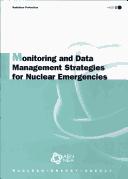| Listing 1 - 10 of 431 | << page >> |
Sort by
|

ISBN: 0387904980 1461260957 1461260930 Year: 1980 Publisher: New York
Abstract | Keywords | Export | Availability | Bookmark
 Loading...
Loading...Choose an application
- Reference Manager
- EndNote
- RefWorks (Direct export to RefWorks)
614.8 --- Emergency management --- -Consequence management (Emergency management) --- Disaster planning --- Disaster preparedness --- Disaster prevention --- Disaster relief --- Disasters --- Emergencies --- Emergency planning --- Emergency preparedness --- Management --- Public safety --- First responders --- Risico. Ongevallen--(voor meer gedetailleerde uitwerking zie e-{614.8}) --- Planning --- Preparedness --- Prevention --- Planning. --- -Risico. Ongevallen--(voor meer gedetailleerde uitwerking zie e-{614.8}) --- Consequence management (Emergency management)
Book
ISBN: 9264192298 9264192190 Year: 2013 Publisher: Paris : OECD Publishing,
Abstract | Keywords | Export | Availability | Bookmark
 Loading...
Loading...Choose an application
- Reference Manager
- EndNote
- RefWorks (Direct export to RefWorks)
This review of Mexico's civil protection system looks at the coordination of multiple actors across the central government, public and private industries, and state and local governments for the effective management of hurricanes, earthquakes and floods.
Risk management --- Emergency management --- Consequence management (Emergency management) --- Disaster planning --- Disaster preparedness --- Disaster prevention --- Disaster relief --- Disasters --- Emergencies --- Emergency planning --- Emergency preparedness --- Management --- Public safety --- First responders --- Insurance --- Moral and ethical aspects. --- Government policy. --- Planning --- Preparedness --- Prevention --- Mexico
Book
ISBN: 0128009039 0128008393 1322114390 9780128009031 9780128008393 Year: 2015 Publisher: Amsterdam, Netherlands : Elsevier,
Abstract | Keywords | Export | Availability | Bookmark
 Loading...
Loading...Choose an application
- Reference Manager
- EndNote
- RefWorks (Direct export to RefWorks)
How do you, as a busy security executive or manager, stay current with evolving issues, familiarize yourself with the successful practices of your peers, and transfer this information to build a knowledgeable, skilled workforce the times now demand? With Security Leader Insights for Business Continuity, a collection of timeless leadership best practices featuring insights from some of the nation's most successful security practitioners, you can. This book can be used as a quick and effective resource to bring your security staff up to speed on security's role in business continuity. Instead
Crisis management --- Emergency management --- Data processing. --- Consequence management (Emergency management) --- Disaster planning --- Disaster preparedness --- Disaster prevention --- Disaster relief --- Disasters --- Emergencies --- Emergency planning --- Emergency preparedness --- Management --- Public safety --- First responders --- Crises --- Management of crises --- Problem solving --- Conflict management --- Planning --- Preparedness --- Prevention

ISBN: 1280034173 9786610034178 9264180958 9789264180956 9264171681 Year: 2000 Publisher: Paris : OECD Publishing,
Abstract | Keywords | Export | Availability | Bookmark
 Loading...
Loading...Choose an application
- Reference Manager
- EndNote
- RefWorks (Direct export to RefWorks)
Since the accident at Chernobyl in 1986, many countries have intensified their efforts in nuclear emergency planning, preparedness and management. Experience from the NEA nuclear emergency exercises (INEX 1 and INEX 2) indicated a need to improve the international system of communication and information in case of a radiological emergency. To address this need, research was carried out by three NEA working groups, the findings of which are synthesised in the present report. This report defines emergency monitoring and modelling needs, and proposes strategies which will assist decision makers by improving the selection of data that is transmitted, and the way in which data and information are transmitted and received. Modern communication methods, such as the Internet, are a key part of the strategies described.
Emergencies. --- Emergency management. --- Nuclear accidents. --- Accidents --- Environmental disasters --- Consequence management (Emergency management) --- Disaster planning --- Disaster preparedness --- Disaster prevention --- Disaster relief --- Disasters --- Emergencies --- Emergency management --- Emergency planning --- Emergency preparedness --- Management --- Public safety --- First responders --- Planning --- Preparedness --- Prevention
Book
ISBN: 0123964741 0123964512 9780123964748 9780123964519 Year: 2015 Publisher: Amsterdam, Netherlands ; Kidlington, England ; Waltham, Massachusetts : Elsevier,
Abstract | Keywords | Export | Availability | Bookmark
 Loading...
Loading...Choose an application
- Reference Manager
- EndNote
- RefWorks (Direct export to RefWorks)
Hazards, Risks, and Disasters in Society provides analyses of environmentally related catastrophes within society in historical, political and economic contexts. Personal and corporate culture mediates how people may become more vulnerable or resilient to hazard exposure. Societies that strengthen themselves, or are strengthened, mitigate decline and resultant further exposure to what are largely human induced risks of environmental, social and economic degradation. This book outlines why it is important to explore in more depth the relationships between environmental hazards, risk and disasters in society. It presents challenges presented by mainstream and non-mainstream approaches to the human side of disaster studies. By hazard categories this book includes critical processes and outcomes that significantly disrupt human wellbeing over brief or long time-frames. Whilst hazards, risks and disasters impact society, individuals, groups, institutions and organisations offset the effects by becoming strong, healthy, resilient, caring and creative. Innovations can arise from social organisation in times of crisis. This volume includes much of use to practitioners and policy makers needing to address both prevention and response activities. Notably, as people better engage prevalent hazards and risks they exercise a process that has become known as disaster risk reduction (DRR). In a context of climatic risks this is also indicative of climate change adaptation (CCA). Ultimately it represents the quest for development of sustainable environmental and societal futures. Throughout the book cases studies are derived from the world of hazards risks and disasters in society.Includes sections on prevention of and response to hazards, risks and disastersProvides case studies of prominent societal challenges of hazards, risks and disastersInnovative approaches to dealing with disaster drawing from multiple disciplines and sectors
Natural disasters --- Emergency management. --- Economic aspects. --- Planning. --- Consequence management (Emergency management) --- Disaster planning --- Disaster preparedness --- Disaster prevention --- Disaster relief --- Disasters --- Emergencies --- Emergency planning --- Emergency preparedness --- Management --- Public safety --- First responders --- Natural calamities --- Planning --- Preparedness --- Prevention --- Emergency management
Book
ISBN: 1464801541 1464801533 Year: 2014 Publisher: Washington, DC : World Bank,
Abstract | Keywords | Export | Availability | Bookmark
 Loading...
Loading...Choose an application
- Reference Manager
- EndNote
- RefWorks (Direct export to RefWorks)
While not all natural disasters can be avoided, their impact on a population can be mitigated through effective planning and preparedness. These are the lessons to be learned from Japan's own mega-disaster: the Great East Japan Earthquake of 2011, the first disaster ever recorded that included an earthquake, a tsunami, a nuclear power plant accident, a power supply failure, and a large-scale disruption of supply chains. It is a sad fact that poor communities are often hardest hit and take the longest to recover from disaster. Disaster risk management (DRM) should therefore be taken into account
Emergency management. --- Risk management. --- Natural disasters. --- Natural calamities --- Consequence management (Emergency management) --- Disaster planning --- Disaster preparedness --- Disaster prevention --- Disaster relief --- Disasters --- Emergencies --- Emergency planning --- Emergency preparedness --- Management --- Planning --- Preparedness --- Prevention --- Insurance --- Public safety --- First responders --- Emergency management
Book
ISBN: 1623961017 1623960991 9781623961015 9781623960995 9781623961008 1623961009 Year: 2013 Publisher: Charlotte, N.C. Information Age Pub.
Abstract | Keywords | Export | Availability | Bookmark
 Loading...
Loading...Choose an application
- Reference Manager
- EndNote
- RefWorks (Direct export to RefWorks)
Plaintext description.
Emergency management. --- First responders. --- Responders, First --- Consequence management (Emergency management) --- Disaster planning --- Disaster preparedness --- Disaster prevention --- Disaster relief --- Disasters --- Emergencies --- Emergency planning --- Emergency preparedness --- Management --- Planning --- Preparedness --- Prevention --- Persons --- Emergency management --- Public safety --- First responders
Book
ISBN: 0128036397 0128036389 9780128036396 9780128036389 Year: 2017 Publisher: Oxford, England : Butterworth-Heinemann,
Abstract | Keywords | Export | Availability | Bookmark
 Loading...
Loading...Choose an application
- Reference Manager
- EndNote
- RefWorks (Direct export to RefWorks)
Integrating Emergency Management and Disaster Behavioral Health identifies the most critical areas of integration between the profession of emergency management and the specialty of disaster behavioral health, providing perspectives from both of these critical areas, and also including very practical advice and examples on how to address key topics. Each chapter features primary text written by a subject matter expert from a related field that is accompanied by a comment by another profession that is then illustrated with a case study of, or a suggested method for, collaboration. Addresses the current state of the collaboration between the emergency management and disaster behavioral health communities as presented from pioneers in their respective fields Focuses on practical examples of what works and what doesn’t Stresses both legal and ethical considerations and the public-private partnerships that are important for leadership in disaster situations Covers Emergency Operations Centers (EOCs) and risk communication
Emergency management. --- Disaster medicine. --- Mass casualties --- Disaster relief --- Emergency medicine --- Medicine --- Consequence management (Emergency management) --- Disaster planning --- Disaster preparedness --- Disaster prevention --- Disasters --- Emergencies --- Emergency planning --- Emergency preparedness --- Management --- Public safety --- First responders --- Treatment --- Planning --- Preparedness --- Prevention --- Emergency management
Book
ISBN: 9264281371 9264281363 Year: 2017 Publisher: Paris : OECD Publishing,
Abstract | Keywords | Export | Availability | Bookmark
 Loading...
Loading...Choose an application
- Reference Manager
- EndNote
- RefWorks (Direct export to RefWorks)
"In 2014 the OECD carried out work to take stock of OECD countries' achievements in building resilience to major natural and man-made disasters. The report suggested that albeit significant achievements were made through effective risk prevention and mitigation management, past disasters have revealed persistent vulnerabilities and gaps in risk prevention management across OECD. Based on the findings of this OECD-wide report a cross-country comparative study was undertaken in Austria, France and Switzerland to test the recommendations put forward in specific country contexts. This report summarises the individual and comparative country case study findings. It highlights that the risk prevention policy mix has shifted in favor of organisational measures such as hazard informed land use planning or strengthening the enforcement of risk sensitive regulations. In the meantime, the great need for maintaining the large stock of structural protection measures has been overlooked and vulnerability might increase because of that. The report highlights the need for better policy evaluation to increase the effectiveness of risk prevention measures in the future. The report highlights practices where countries succeeded to make risk prevention a responsibility of the whole of government and the whole of society, by analysing supporting governance and financing arrangements."--Back cover.
Emergency management --- Risk management --- Insurance --- Management --- Consequence management (Emergency management) --- Disaster planning --- Disaster preparedness --- Disaster prevention --- Disaster relief --- Disasters --- Emergencies --- Emergency planning --- Emergency preparedness --- Public safety --- First responders --- Planning --- Preparedness --- Prevention
Book
ISBN: 0128162414 0128162406 9780128162415 9780128162408 Year: 2020 Publisher: Kidlington, Oxford, United Kingdom
Abstract | Keywords | Export | Availability | Bookmark
 Loading...
Loading...Choose an application
- Reference Manager
- EndNote
- RefWorks (Direct export to RefWorks)
Emergency management --- Planning. --- Consequence management (Emergency management) --- Disaster planning --- Disaster preparedness --- Disaster prevention --- Disaster relief --- Disasters --- Emergencies --- Emergency planning --- Emergency preparedness --- Management --- Public safety --- First responders --- Planning --- Preparedness --- Prevention
| Listing 1 - 10 of 431 | << page >> |
Sort by
|

 Search
Search Feedback
Feedback About UniCat
About UniCat  Help
Help News
News